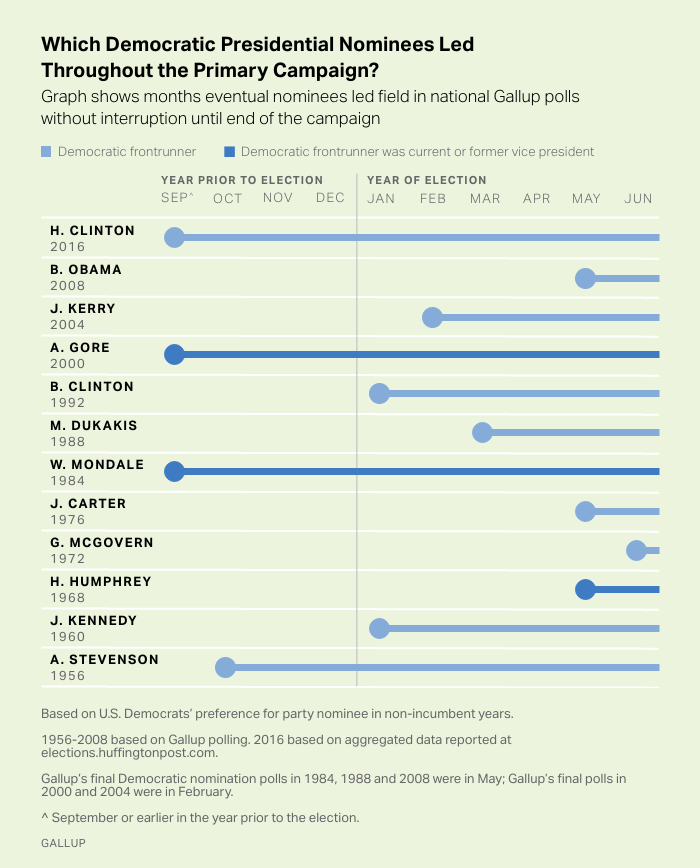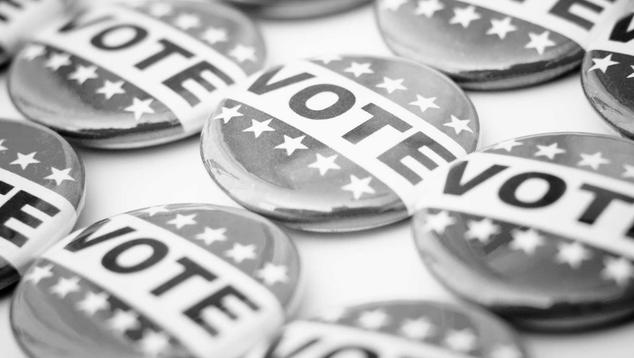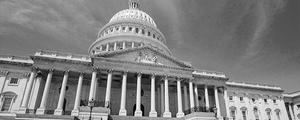This post looks at historical data on Democrats' and Republicans' preferences for their party's presidential nominations from 1952 to 2016, showing when party nominees have typically established a continuous lead in nomination preference polls.
In brief: Presidential nominees leading throughout the primary campaign has been the exception, not the rule, for Democratic candidates over the past six decades. This has been the case for a variety of reasons -- including because some eventual nominees didn't enter the race until late in the campaign or because the early frontrunner dropped out along the way. Republican nominees, meanwhile, have tended to lead the pack for the entire campaign, with a few exceptions.
For both parties, leading continuously didn't mean that the person was a shoo-in. National conventions or primary elections typically were still hard fought. Also, popular opinion wasn't as relevant to the selection of party nominees before 1972, when binding primaries came into regular use.
The monthly results displayed in the graphs that follow are based on Gallup data showing the nomination preferences for each major party from the 1952 to 2012 elections. The 2016 election results are based on polling averages reported on HuffPost.com.
Eight of 12 Democratic Nominees Emerged Late
Between the election years of 1956 and 2016, there were 12 non-incumbent races for the Democratic nomination for president. In four of these races, the eventual nominee led throughout the entire nomination campaign dating back to the year before the election. All four of these early leaders were very high-profile going into the campaign:
- Adlai Stevenson, in 1956, had been the party's nominee in 1952.
- Walter Mondale, in 1984, had been the party's vice president in the prior Democratic administration.
- Al Gore, in 2000, was the incumbent vice president.
- Hillary Clinton, in 2016, was the former first lady, former secretary of state and a strong contender in the 2008 Democratic campaign.
In the other eight non-incumbent Democratic races, the eventual nominee didn't emerge as the sustained leader in Gallup's national polling until after the start of the election year.
- Three of these nominees -- Barack Obama in 2008, John Kerry in 2004 and John F. Kennedy in 1960 -- were among the top-ranked candidates at points in the year before the election. But it was January of the election year or later before they established a lead they did not relinquish.
- The other five late-blooming Democrats were never among the top-ranked candidates in the year before the election. These were Bill Clinton in 1992, Mike Dukakis in 1988, Jimmy Carter in 1976, George McGovern in 1972 and Hubert Humphrey in 1968. Humphrey, however, was a special case, in that as the sitting vice president he didn't announce his candidacy until April of the election year, only after President Lyndon Johnson announced he would not seek another term.

Early Frontrunners Dominated Republican Nominations
Republican primary races have been more likely to feature a candidate who dominated the field throughout the campaign before eventually winning the nomination. This was the case for the nominee in seven of the past 11 races for the Republican nomination with no incumbent running: Donald Trump in 2016, George W. Bush in 2000, Bob Dole in 1996, George Bush in 1988, Ronald Reagan in 1980, and Richard Nixon in both 1968 and 1960.
Both sitting or former vice presidents who sought the Republican nomination over this period -- George Bush and Richard Nixon -- were in this category of candidates who captured the top spot early and held it for the duration.
In three other GOP primary races, the eventual nominee didn't secure the top spot in Gallup polls until a month or more into the election year: Mitt Romney in 2012, John McCain in 2008 and Dwight Eisenhower in 1952.
- While Romney and McCain were both strong contenders before their election year, they trailed other candidates for all or part of that time.
- Eisenhower led the GOP field throughout Gallup's polling in 1951, but was tied with Robert Taft in January and February 1952 before recapturing the clear lead.
Barry Goldwater is the only candidate from either party who did not lead in Gallup's final party preference polls before winning the nomination. He was Republicans' favorite for several months in 1963, but he trailed other GOP contenders in 1964. In the final poll before the Republican National Convention, Goldwater was essentially tied with Nixon (who wasn't officially running that year) and Henry Cabot Lodge and William Scranton (who did actively campaign) for the top spot.

Implications for 2020
Gallup's historical preference polls for the Republican and Democratic nominations show that much can change in voter preferences in the last six to 12 months before the parties' nominating conventions. Candidates who have emerged early on as the favorite among the party's rank-and-file often have succeeded in capturing the nomination. However, across both major parties, there are just as many examples of the winner not emerging from the field until the start of the election year or later.
The historical guidance for a vice presidential candidate, such as Joe Biden, isn't clear. All four sitting vice presidents who ran for their party's nomination succeeded: Gore in 2000, Bush in 1988, Humphrey in 1968 and Nixon in 1960. And of these, those who entered the race early (all but Humphrey) led the field early. Of the four candidates who ran as former vice presidents -- Dan Quayle in 2000, Mondale in 1984, Humphrey in 1972 and Nixon in 1968 -- two (Mondale and Nixon) led early and captured the nomination; one (Humphrey) picked up steam midway, but lost; and one (Quayle) never got off the ground, polling weakly in 1999 before dropping out after a few months. Biden has led the field in national polls continuously all year, but with his margin over Elizabeth Warren narrowing a full four months before the start of the primary season, there is no precedent to indicate the likelihood he will hold on.




